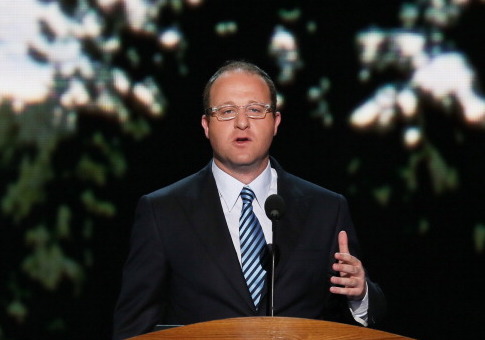Colorado gubernatorial candidate and current U.S. representative Jared Polis sidestepped the question of cost for his goal of making the state's energy production 100 percent based on renewable forms like wind and solar by 2040.
In an interview with NewsRadio KOA in Denver, Polis said he believed 100 percent renewable energy production would eventually "bring down rates," but did not elaborate further.
When asked about the feasibility of getting to 100 percent renewables by 2040, Polis said, "This is the way the world is headed, this is the way Colorado is headed," and then pointed listeners to the plan on his campaign website.
"Many cities and counties are stepping up and having even more aggressive goals," Polis added. "So Pueblo, where I launched my campaign for governor, has adopted a goal of 2035 for 100 percent renewable energy."
"The first county in Colorado, Summit County, just committed to 100 percent renewable by 2030, so this is happening, we just need state leadership." He also touted anticipated job creation for the transition and maintenance. Polis on his website said those jobs "can never be outsourced."
No part of the response by Polis on-air or on his website mentions a dollar figure for infrastructure investment or what reaching the goal could cost citizens before potential savings are realized.
His website states, "Projections show that reaching our renewable energy goals in Colorado will create over 49,000 construction jobs and over 21,000 operations jobs while saving consumers 10 percent on energy costs," and cites a website called thesolutionsproject.com. That website sourced their data and analysis back to Stanford University.
However, the Stanford University data from Mark Jacobson has recently come under fire from a group of scientists who published a paper with the National Academy of Science. They refuted his findings, saying the "analysis involves errors, inappropriate methods, and implausible assumptions."
A request for comment from the Polis campaign about the investment costs was not returned.
The Independence Institute in Denver commissioned a study of the costs to the state for a 100 percent renewable portfolio. (Disclosure: The author of this article was previously employed by the Independence Institute.)
That study did two analyses side by side. In the first, carbon-based energy producers would be able to purchase credits from renewable producers in other states. The cost estimates in the paper ranged from a low of $500 million to a high end of just under $4 billion.
In the second case, energy producers had to scrap all carbon-based sources and supplant them with renewables. The research estimated all costs for that transition, including adding battery capacity and retiring coal and gas plants, at just under $45 billion.
Myron Ebell, the director of the Center for Energy and Environment with the Competitive Enterprise Institute, said campaign promises like these depend on the goals being set in the distant future.
"For the people who promote this nonsense, it's lucky for them that the deadlines are far into the future," Ebell said. "If there was a target to get to 'X' percent by 2022, or 2025, then they would have to start making a lot of these hard decisions that would cost a lot of money right now."
Ebell agreed that in the intervening years, technological advances in solar capacity, battery storage, and other areas will lower prices, but said there are still too many unknown variables and other hard costs that remain unavoidable. He also noted that some carbon-based generation will need to remain to provide energy in down times for the renewables, and says that kind of electricity will become more expensive as it becomes more rare.
The cost analysis from the Independence Institute set off a minor twitter war with Polis and the think tank's president, with Polis arguing he was not advocating a strict mandate, and argued that the think tank’s analysis didn’t mirror his approach.
"The way we plan to get our state to 100 percent renewable by 2040 … is a bottom-up approach using market mechanisms, like encouraging distributed wind and solar projects, removing regulatory barriers to siting wind projects on state lands and lots of other things I could go into in detail," Polis told ColoradoPolitics.com, a project of the Colorado Springs Gazette.
Polis's renewables goal is an extension of previous battles engaged in by the congressman.
Polis sponsored two ballot measures in 2014 that would have curtailed oil and gas extraction, especially operations that used hydraulic fracturing. Gov. John Hickenlooper, on the ballot for reelection that year, brokered a compromise in which both Polis and industry concerns agreed to withdraw their proposed ballot measures, and also created an oil and gas task force assigned to make recommendations to the state's general assembly.
The push for those ballot questions came one year after the congressman had sued an energy company over a fracking operation located near a rural getaway home he owned close to Greeley, a town that's benefitted greatly from the energy boom resulting from the fracking technology.
One of Polis's closest competitors in the governor's race, State Sen. Mike Johnston, is running on a similar goal of 100 percent renewable production by 2040, and told the Denver Post his plan favored a series of "benchmarks" as opposed to a legislative mandate.
"This whole thing is big talk, and if the big talk ever turned into action, it would be incredibly expensive for producers," Ebell said.
Polis, generally thought to be one of the 10 wealthiest members of Congress, is also presumed to be the frontrunner for the Democratic nomination, in part because of his willingness to use his personal fortune to underwrite his campaign. According to the Colorado Secretary of State's campaign finance database, Polis donated over $1.3 million to his campaign in 2017.
